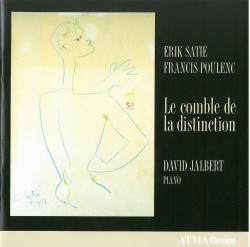Satie; Poulenc – Le comble de la distinction
David Jalbert
ATMA ACD2 2683
Review
Francis Poulenc (1899-1963), composer and pianist, was a man of many contradictions, perpetually vacillating between the sacred and profane. Paradoxically, this bipolar anxiety constitutes the very essence and charm of his music. His sometimes drastic stylistic mood swings are exemplified in Jalbert’s deeply affectionate performance of Poulenc’s Soirées de Nazelles that opens this album, a lengthy work for solo piano consisting of a series of 11 musical portraits of personalities he encountered while on vacation in central France. The music of Erik Satie (1866-1925) is interspersed throughout this album in a compelling dialogue with Poulenc’s. Poulenc himself greatly enjoyed the company of Satie in that composer’s twilight years, finding him “marvellously funny” and a fertile source of musical and spiritual inspiration. In fact, Poulenc’s public debut composition, the Rapsodie nègre of 1917, is dedicated to him. Jalbert’s hypnotic performance of Satie’s austere Trois Gymnopédies is followed by Poulenc’s three unusually focused Mouvements perpétuels. Poulenc the magpie is here too, in the form of two Improvisations honouring Schubert and Edith Piaf. The subsequent selections of Satie’s Valses distiguées… and Je te veux invoke the spirit of the cabaret that Poulenc also expressed so well. Poulenc the miniaturist returns to centre stage in the final selection, a masterly rendition of the kaleidoscopic Nocturnes composed over the course of 1929-1938.
In an age of knuckle-busting keyboard technicians fixated on a single era, composer or concerto it is a great pleasure to encounter an artist of Jalbert’s stature for whom the piano is simply a transcendent means of human expression. My only frustration with this admirable disc is the generic program notes which fail to explain the ironic subtitles of the two Poulenc suites. For the record, the title track has been rendered elsewhere as “The epitome of distinction.”




